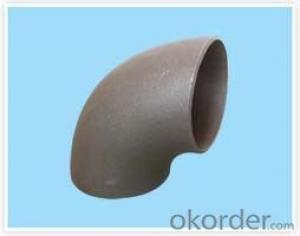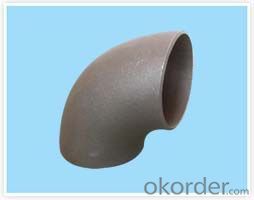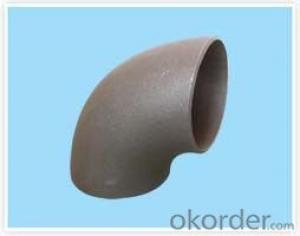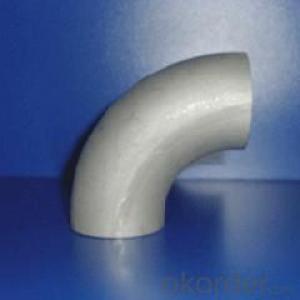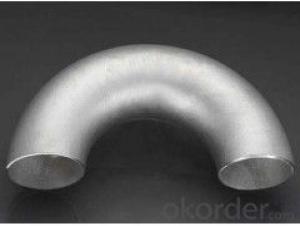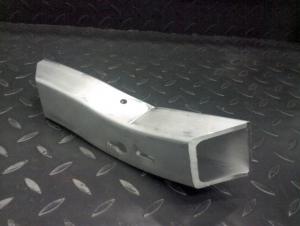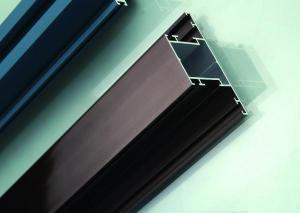Bosch Profiles Aluminum 60 Degree Aluminum Elbow
- Loading Port:
- China Main Port
- Payment Terms:
- TT OR LC
- Min Order Qty:
- -
- Supply Capability:
- -
OKorder Service Pledge
OKorder Financial Service
You Might Also Like
Specifications
60 degree aluminum elbow
1.size:1/2"-48"
2.standard:ASTM B16.9
3.Certification: ISO
Type | 60 degree elbow |
Size | 1/2"-48"DN15--DN1200 |
Wall Thickness | Sch5--Sch160XXS |
Standard | ISO, SNSI, JIS, DIN, GB/T12459GB/T13401ASME B16.9SH3408 SH3409HG/T21635HG/T21631SY/T05010 |
Material | 20#/Q235 |
Packaging | wooden cases or wooden pallet or as per customers requirement |
Applications Range | petroleum, chemical, power, gas, metallurgy, shipbuilding, construction, etc |
Min Order Quantity | According to customer's requirement |
Delivery Time | According to customer's requirement |
Quality | First grade |
Productivity | 8000000T/Y |
Others | 1.Special design available according to requirement 2.Anti-corrosion and high-temperature resistant with black painting 3. All the production process are made under the ISO9001:2008 strictly. |
- Q: This question asks about the variety of colors offered for aluminum profiles used in exterior siding and trim applications.
- <p>Aluminum profiles for siding and trimming are available in a wide range of colors to suit various architectural styles and design preferences. Common colors include white, black, brown, beige, and gray, which are popular for their neutrality and versatility. Additionally, there are bolder options such as red, blue, green, and yellow for more distinctive looks. Some manufacturers also offer custom color matching services for specific projects. The finishes can be powder-coated or anodized, providing durability and resistance to weathering. It's always best to check with specific manufacturers for the most up-to-date color offerings as they may introduce new colors or discontinue others based on market trends.</p>
- Q: What are the vibration damping properties of aluminum profiles?
- Aluminum profiles have excellent vibration damping properties. Due to their high stiffness-to-mass ratio, aluminum profiles effectively absorb and dissipate vibrations, reducing their magnitude and preventing their transmission to surrounding structures. This property makes aluminum profiles ideal for applications where vibration control is critical, such as in the aerospace, automotive, and construction industries. The inherent damping characteristics of aluminum profiles help in minimizing noise, minimizing wear and tear, and ensuring structural integrity. Additionally, aluminum's ability to dampen vibrations also enhances the overall comfort and safety of various products and structures.
- Q: Are aluminum profiles suitable for automotive heat exchangers?
- Automotive heat exchangers can effectively utilize aluminum profiles due to their numerous advantages. Firstly, aluminum possesses outstanding thermal conductivity, enabling efficient heat transfer between mediums. This quality allows aluminum heat exchangers to effectively dissipate heat generated by vehicle components such as the engine or transmission. Secondly, aluminum profiles are both lightweight and strong, making them a preferred option in the automotive industry. Weight reduction is crucial for improved fuel efficiency and performance, and aluminum heat exchangers contribute to this goal. By utilizing aluminum, overall weight is reduced, resulting in better handling, acceleration, and energy efficiency. Furthermore, aluminum exhibits high resistance to corrosion, even in harsh environments, making it highly suitable for automotive applications. This corrosion resistance ensures the durability and reliability of heat exchangers, reducing maintenance and replacement costs. Additionally, the manufacturing and formation of aluminum profiles into complex shapes is a simple task. This flexibility in design allows for customized heat exchanger designs that meet specific automotive requirements. The ability to efficiently utilize available space and maximize heat exchange surface area enhances overall performance. In conclusion, aluminum profiles are an excellent choice for automotive heat exchangers due to their exceptional thermal conductivity, lightweight yet strong properties, corrosion resistance, and design flexibility. These qualities make aluminum the ideal material for effectively managing heat in vehicles, resulting in improved performance, fuel efficiency, and durability.
- Q: What are the advantages of using aluminum profiles in the defense industry?
- There are several advantages of using aluminum profiles in the defense industry. Firstly, aluminum profiles offer a high strength-to-weight ratio. This means that they can provide the necessary strength and durability while being lightweight. This is particularly crucial in the defense industry where weight reduction is essential for enhancing mobility and reducing fuel consumption. Secondly, aluminum profiles have excellent corrosion resistance properties. This is particularly advantageous in defense applications where equipment is exposed to harsh environments, such as saltwater or extreme weather conditions. The corrosion resistance of aluminum profiles ensures that the equipment remains functional and reliable for extended periods, reducing maintenance requirements and increasing the overall lifespan of the components. Furthermore, aluminum profiles are highly malleable and can be easily fabricated into complex shapes and designs. This versatility allows for greater design flexibility in defense applications, enabling the creation of intricate and tailored components. Additionally, aluminum profiles can be easily joined with other materials, such as composites or steel, further expanding their potential applications in the defense industry. Another advantage of aluminum profiles is their excellent thermal conductivity. Aluminum has a high thermal conductivity compared to other metals, allowing for efficient heat dissipation in defense equipment. This is particularly important in applications where thermal management is critical, such as electronic systems or high-performance vehicles. The ability of aluminum profiles to dissipate heat effectively ensures the reliability and longevity of sensitive components. Lastly, aluminum is a widely available and cost-effective material. It is abundant in nature and can be easily extracted, making it readily accessible for defense manufacturing. Moreover, its low cost compared to other metals such as titanium or steel makes it an economical choice for defense applications, allowing for cost-effective production of large quantities of components without compromising on quality or performance. In conclusion, the advantages of using aluminum profiles in the defense industry include their high strength-to-weight ratio, corrosion resistance, versatility in fabrication, excellent thermal conductivity, and cost-effectiveness. These characteristics make aluminum profiles an ideal choice for a wide range of defense applications, contributing to enhanced performance, durability, and cost-efficiency in this critical sector.
- Q: Are aluminum profiles suitable for use in chemical processing environments?
- Yes, aluminum profiles are suitable for use in chemical processing environments. Aluminum is a versatile and corrosion-resistant material that can withstand exposure to a wide range of chemicals. It has excellent resistance to many common chemicals, including acids, bases, and solvents. Additionally, aluminum profiles can be further protected by applying specialized coatings or finishes, such as anodizing, which enhances their resistance to chemical corrosion. Furthermore, aluminum profiles offer other advantages in chemical processing environments, such as their lightweight nature, high strength-to-weight ratio, and ease of fabrication. These qualities make aluminum profiles a preferred choice for various applications in chemical processing industries, including the construction of tanks, piping systems, and process equipment.
- Q: How are aluminum shapes made?
- 1, is the first process of production of aluminum casting. The main process is: (1) batching: according to the needs of the production of specific alloy grade, calculated the addition of various alloy ingredients, reasonable collocation of various raw materials. (2) smelting: the raw material is added into the melting furnace according to the process requirements, and the impurity and gas in the melt can be removed effectively through degassing and slag refining. (3) casting: molten aluminum liquid, in a certain casting process conditions, through the deep casting system, cooling casting into various specifications of round cast bar.
- Q: The subject is aluminum bearing in what u ~ on both sides of the track?? How can the track be fitted into this slot? Both sides secure 50Mechanical expert answers!The subject is aluminum bearing in what u ~ on both sides of the track?? How can the track be fitted into this slot? How can the seat of fixed motor on both sides be connected with the section bar?
- The link between the motor seat and the profile is bolted. Screw holes in the track, and bolts on the motor seat are screwed into the threads of the profiles.
- Q: Explain if aluminum profiles can be utilized in constructing energy-efficient building systems and if so, how they contribute to energy efficiency.
- <p>Yes, aluminum profiles can be used to create energy-efficient building systems. They are lightweight yet strong, which reduces the energy required for construction. Aluminum profiles also have excellent thermal conductivity, allowing them to be used in double-glazed windows and doors, improving insulation and reducing heat loss. Additionally, aluminum can be easily recycled, reducing the energy needed for new materials. Their high reflectivity can also help in reducing heat absorption, further contributing to energy efficiency.</p>
- Q: Are aluminum profiles suitable for use in furniture fittings and accessories?
- Yes, aluminum profiles are suitable for use in furniture fittings and accessories. Aluminum is lightweight, durable, and resistant to corrosion, making it an ideal material for various furniture applications. Additionally, aluminum profiles can be easily fabricated into different shapes and designs, allowing for versatility in furniture design.
- Q: How do aluminum profiles perform in terms of UV resistance?
- Aluminum profiles generally offer good UV resistance. The natural oxide layer that forms on the surface of aluminum provides some level of protection against UV radiation. However, the performance of aluminum profiles in terms of UV resistance can vary depending on various factors such as the specific alloy used, the quality of surface treatment, and the environmental conditions they are exposed to. Alloys that contain higher amounts of copper, such as 6000 series aluminum, tend to have better UV resistance than pure aluminum or alloys with lower copper content. This is because copper enhances the natural oxide layer's ability to withstand UV radiation. In terms of surface treatment, aluminum profiles that undergo proper anodizing or powder coating processes tend to have improved UV resistance. Anodizing involves creating a thicker and more durable oxide layer on the surface of the aluminum, which enhances its ability to resist UV damage. Powder coating, on the other hand, involves applying a protective layer of polymer to the aluminum surface, which acts as a barrier against UV radiation. Environmental conditions can also affect the UV resistance of aluminum profiles. Intense sunlight, high temperatures, and exposure to pollutants or corrosive substances can accelerate the degradation of the oxide layer and reduce the overall UV resistance. Regular cleaning and maintenance can help prolong the lifespan and UV resistance of aluminum profiles. In summary, aluminum profiles generally offer good UV resistance due to the natural oxide layer on the surface. Factors such as alloy composition, surface treatment, and environmental conditions can influence their performance in terms of UV resistance. It is recommended to consult with manufacturers or suppliers to ensure that the specific aluminum profiles meet the required UV resistance for the intended application.
Send your message to us
Bosch Profiles Aluminum 60 Degree Aluminum Elbow
- Loading Port:
- China Main Port
- Payment Terms:
- TT OR LC
- Min Order Qty:
- -
- Supply Capability:
- -
OKorder Service Pledge
OKorder Financial Service
Similar products
Hot products
Hot Searches
Related keywords
